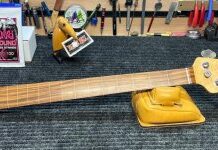re: getting the most life out of your G Force- PROTECT THEM!!
To present G Force owners, ALWAYS use a very high quality surge suppressor/ power conditioner/and or battery backup, with a SOLID GROUND for your G Force! always!
that way, power surges, spikes, brown outs and other damaging electronic transients will be filtered away from your pricey G Force and safely away to ground.
low power Digital devices are highly susceptible to damage from power overloads, surges, spikes and voltage irregularities. what happens when sensitive micro-circuitry that is thousands of times smaller than a human hair breaks down? We’re not talking about big factory refrigerators or heating systems. It’s easy to see the damage when, for whatever reason, those items grind to a halt.
We’re talking about nanometer transistors so small that 100 million of them would fit on the head of a pin. We’re also talking about firmware that can contain millions of lines of complex code.
Maybe you know this story: There’s a thunderstorm. Lightning strikes nearby. The power cuts out for a moment, then returns. But when you try to switch on the TV, it doesn’t seem to work.
Electrical surges can instantly overload and short out the circuitry of home electronics and anything else plugged into the wall, or they can degrade them over time. Learning more about surges can help save money and how to protect your property.
How does a power surge cause damage?
In the United States, most homes use electrical power in the form of 120 volt, 60 hertz, single phase, alternating current.
However, the voltage is not delivered at a constant 120 volts. With alternating current, the voltage rises and falls in a predetermined rhythm. The voltage oscillates from 0 to a peak voltage of 169 volts. Most appliances and electronics used in the United States are designed to be powered by this form of generated electricity.
But during a power surge, the voltage exceeds the peak voltage of 169 volts.
A spike in voltage can be harmful to appliances and electrical devices in your home. Increasing voltage above an appliance’s normal operating voltage can cause an arc of electrical current within the appliance, and the heat generated in the arc can cause damage to the electronic circuit boards and other electrical components.
Smaller, repeated power surges could be the reason your TV, PC. or electronics mysteriously stops working. These smaller surges can slowly cause damage, so your computer or stereo may continue to function until the integrity of the electronic components finally erode. This shortens the life span of appliances and electronics.
A power surge can reach your home, fry your circuit breakers and spread to your outlets. If a device or appliance is plugged in, it may not survive the sudden surge of electricity.
So what can you do to make sure your electronics survive an electrical surge? Start with surge protectors, both large and small.
Whole-house surge protectors are installed at the main electrical service panel, where the circuit breakers or fuses are located. The suppressor will channel the extra electricity during the power surge and prevent it from getting into your main system.
You can also use surge protector power strips for each of your sensitive appliances and electronics. These protectors work like the whole-house suppressors, but on a smaller scale. They can provide you some peace of mind the next time there’s a storm.
Filtering the power alone could knock away 50-60% or more of potential hazards for G-Forces (AND 1210’s & 2290’s for that matter!).
If G-Forces have been discontinued, cannot be repaired, and we cannot get replacement parts, the only thing WE cqn actively do is protect the hell out of them, and maybe we won’t try to turn ours on one day, only to find it doesn’t work!
Source: http://forum.tcelectronic.com







